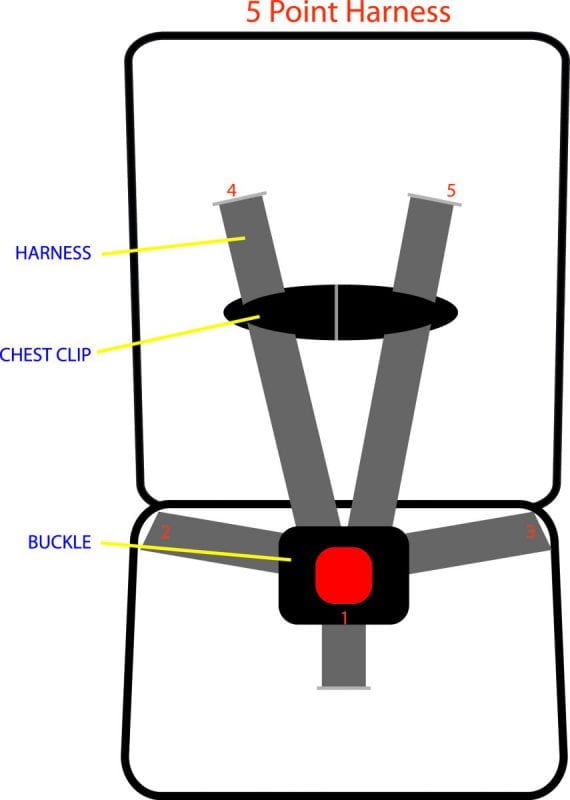Harnessing: 5 Points
Harnessing your child the right way is just as important as the careful installation of your child’s car seat (See also Part I of this series: Car Seat Selection and Direction, and Part II: Installation). Once the car seat is installed, you will want to secure your child properly using the harness system. In the United States we use “5 Point Harness” systems. This is comprised of a buckle, a chest clip, and the harness (webbing) which contacts the five strongest parts of the body to spread the force of a crash evenly over the child: across the hips (points 1 & 2), over each shoulder (points 3 & 4), and between the legs (point 5).

- Properly position the harness on your child.
- Rear-facing seats – Harness straps should lie flat, not twisted, and be routed through the slot that is at or below your child’s shoulders.
- Forward-facing seats – Harness straps should lie flat, not twisted, and be placed through the slot that is at or above your child’s shoulders.
Twisted Harness
A twisted harness will not distribute weight correctly in a crash and could cause injury. Make sure the harness straps are routed through the correct slot in both the car seat cover and car seat shell, especially after removing the cover for any reason. Often, the harness will accidentally be routed through one slot in the cover but not the corresponding slot in the shell.
- Buckle the harness and close the chest clip. Tighten the harness straps and move the chest clip up so the top of the clip lines up at armpit level.
- Check to see that the harness is snug by administering the “pinch test”. You should not be able to pinch a horizontal fold in the harness webbing at the child’s collar bone.


Harnessing and New Babies
You want to make sure nothing comes between your child and the car seat, or the harness straps. This includes BundleMes, buntings, bulky coats, and swaddle blankets. In the next article we will discuss some solutions for winter time. This is a very informative video by Dr. Alisa Baer (“The Car Seat Lady”) on what every parent should know before buckling his or her new baby into a car seat:
Common Harness Errors
- Harness too loose or bulky Items under harness

- Chest clip not at armpit level

- Harness twisted

- Buckle unbuckled (but chest clip is closed)

- Chest clip not closed (but bottom buckle is buckled)

- Harness routed through incorrect slots, or routed through two different slots
- Harness and seat belt both used to secure the child (this can sometimes be found on a forward facing child in a car seat installed using LATCH or not installed at all)
Tomorrow, Part IV of this series: The Comprehensive Guide to Car Seat Safety Part IV .
